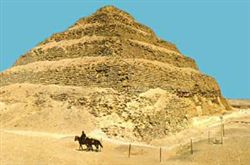
Pyramid of King Djoser (c. 2667-2648 BC) at Saqqara - the first pyramid. The architect was Imhotep. The tomb was originally conceived as a huge mastaba. It was gradually enlarged to a six-stepped structure, rising to a height of 60 m in the middle of the pyramid complex. The whole area measures 277 x 544 m and is surrounded by a high wall in which one real and fourteen false doors were placed. Apart from the pyramid itself, the complex comprises several open courtyards, in part connected with the Sed Festival of Djoser, a mastaba tomb (usually called the 'Southern tomb'), two buildings which have been interpreted as representations of the shrines of Upper Egypt and Lower Egypt, a building to the north of the pyramid with unknown functions (it may be a temple or palace), a serdab with a statue of the king, and several other buildings. Both the pyramid and the Southern tomb have subterranean corridors, partly decorated with blue faience tiles. Here are reliefs showing the king performing rituals during his royal jubilee. Beneath the pyramid are the burial chambers of the king and 11 members of his family. The pyramid complex was entirely built in stone, imitating the perishable materials of which earlier constructions would have been made.